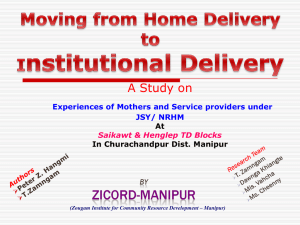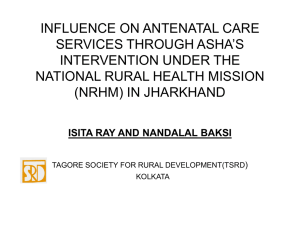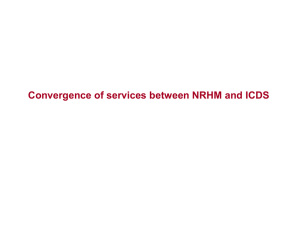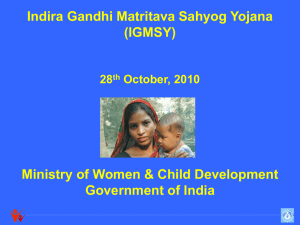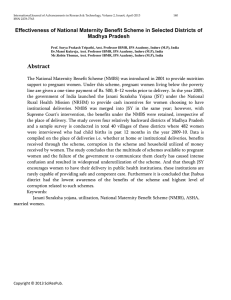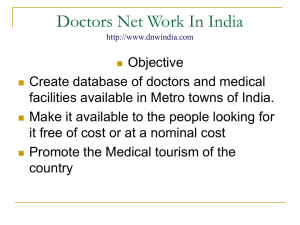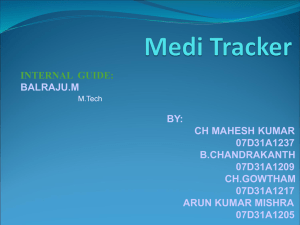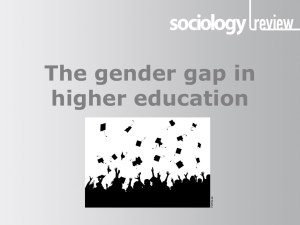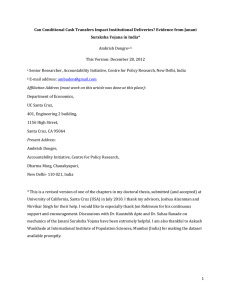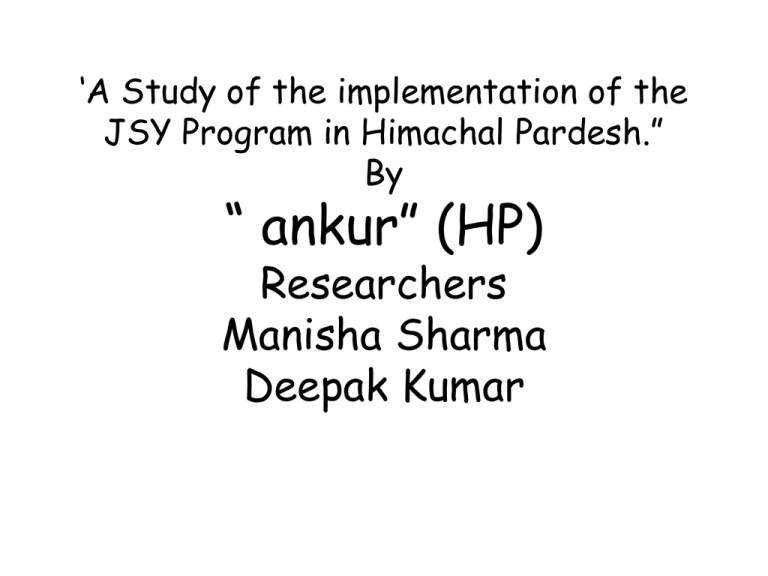
‘A Study of the implementation of the
JSY Program in Himachal Pardesh.”
By
“ ankur” (HP)
Researchers
Manisha Sharma
Deepak Kumar
Lay out of the Presentation
•
•
•
•
•
•
•
•
JSY-The Program
Objectives of the Study
Study population
Methodology
Key findings
Recommendations
Limitations
Conclusions
Janani Sureksha Yojna
(Safe Motherhood Program
– Launched in the year 1997, as a National
Maternity Benefit Scheme (NMBS) with
the aim to provide cash assistance to the
women of BPL family during her last
semester. This assistance was to improve
her nutritional status.
– Under this revised scheme certain cash
benefit to the beneficries as well as to the
motivator have been attached to promote
institutional deliveries.
Main objectives of the study
• To know how the introduction of JSY
Program in the last year have brought a
change in the lives of the women who
have delivered & in the health
practitioner (Formal and informal) who
have played a role in women assessing
these health requirements. If not what
are the constraints..
Geographical area of study
Geographical Areas of Study-Himachal Pradesh, District UNA,
Our Focus Populations for Study..
1. Women who have delivered in
institutions between 2007-2008.
2. Women who have delivered at homes
(registered in JSY) between 20072008
3. Govt Health Providers (AWW/ ANMs/
Doctors)
4. Private Health Providers (Traditional
Midwives/ Private Doctors)
Himachal Pradesh
Other 11
Districts
District UNA
Gagret Block
Other 4 Blocks
Gagret PHC
Others 5 PHCs
Doulat Pur
PHC
SubCenterTh
aplan
Sub-Center
Ambota
Sub Center
Oel
Sub-Center
Kaloh
Sub-Center
Mawakohlan
Methodology for Study
Survey of the women who have delivered during 2007-08
In depth interviews
291
FGD-women who have delivered at home and in the institution.
6
Medical Officer
1
Block Medical Officer
5
Registered Medical Practitioners
6
FGD-with Trained birth attendant.
Interviews ANM
One with each group.
6
5
Key finding-Why women choose home
over Institutions for the delivery.
• lack of confidence in health institutions.
• Lack of sensitivity of the institutions,
anger expressed towards the antipathy
of the system.
• Actual cost is more, costly medicine at
emergency difficulty in accessing JSY
incentives.
• No cure is available for obstetric
emergency.
• Difficulty in accessing JSY money.
• Women do not decided the place of
delivery.
•
•
•
•
Findings
why women choose to deliver at
facility
Women from nuclear and migrant families.
Women who go far sex selective
deliveries-precious male child to be
delivered.
Women who had adverse experiences
from TBA and ANM of delivering at home.
Women get motivated by ANM.
Findings
perception of the health functionaries
• Administration could not decide between ASHA and AWW.
• Doctors have limited knowledge of the JSY and its components.
• They agreed that health facilities lack emergency obstetric care
services.
• Communication gap between beneficiaries and services providers.
• Services providers were also of the view that the process of getting
incentives is cumbersome
• Most of the doctors have admitted that there knowledge of the JSY
is limited to monitory benefits..
• They agreed that health facilities lack emergency obstetric care
services.
• Communication gap between beneficiaries and services providers.
• Services providers were also of the view that the process of getting
incentives is cumbersome
Recommendations.
•
Appoint ASHA to bridge the communication gap between beneficiaries
and health facilities.
•
Provide good quality obstetric care to build confidence among
communities to use them for the maternal emergencies.
•
If administration failed to post specialist in the FRU, Promote Public
Private Partnership by accrediting doctors/ clinic/ nursing home to
provide emergency obstetric care. .
•
Provisions for regular and good quality capacity building program for
AWW and ANM to make the system sensitive to women maternal needs.
•
Appoint more women doctors particularly gynecologist in the
government health system to motivate women for institutional
deliveries.
Limitations of the study.
• The scope of the finding of this study is
limited to the concentration of
particular cast (SC/St) in the study
areas.
Conclusion
• The JSY scheme has the potential to
increase the proportion of institutional
deliveries.
• In order to increase the effectiveness of
the JSY cash incentive, we need to build
the confidence of women in institutional
deliveries by improving health
infrastructure and quality of care.
Thank you

